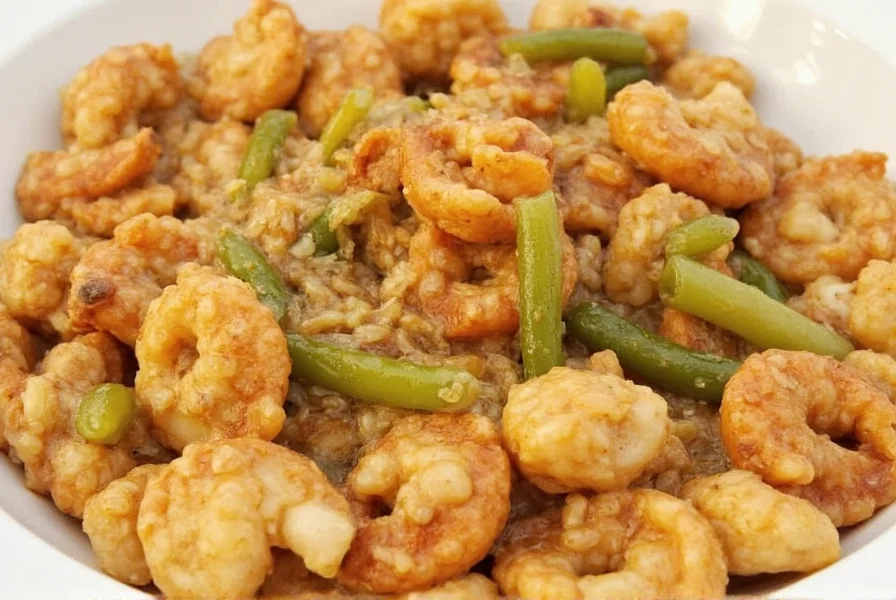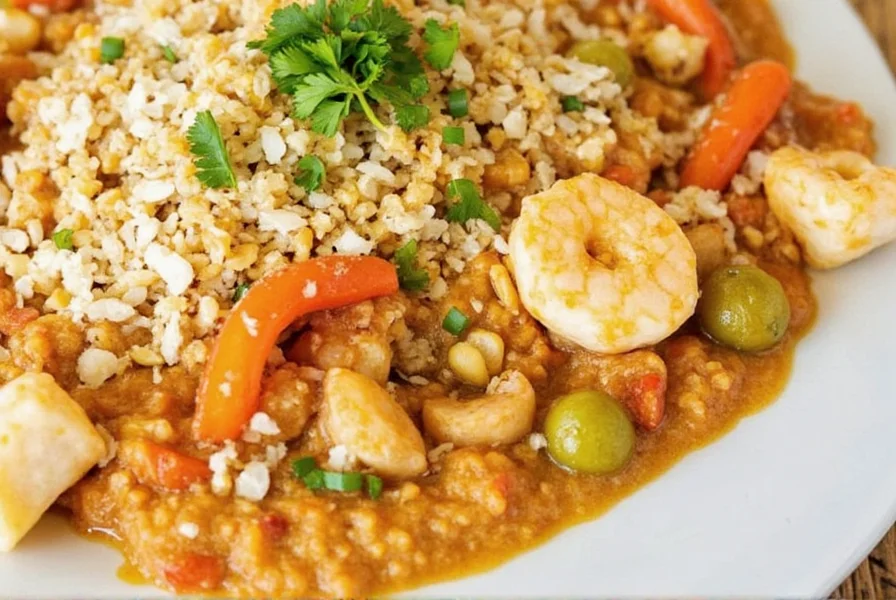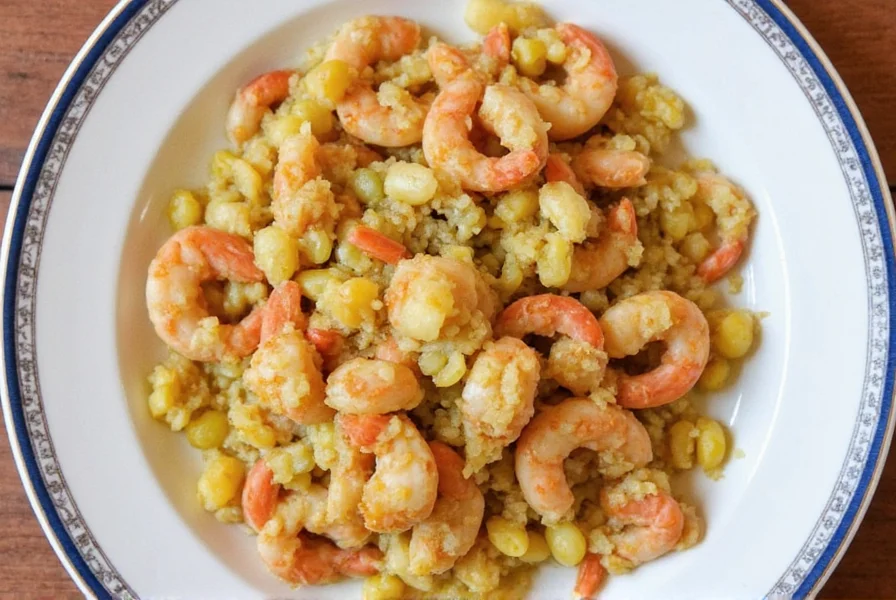Authentic Seafood Étouffée Recipe: Step-by-Step Guide
Here's a complete, authentic seafood étouffée recipe that delivers rich Louisiana flavor. This dish features fresh spices, proper technique, and simple steps for a restaurant-quality meal at home. Below you'll find all ingredients, detailed instructions, spice tips, and storage advice to master this classic dish.
Historical context: Étouffée evolved from Acadian culinary traditions after 1765, adapting French "smothering" techniques to Louisiana's abundant shellfish. The first documented crawfish étouffée recipe appeared in The Picayune's Creole Cookbook (1921), with shrimp becoming prevalent during 1980s commercial fishing expansions (New Orleans Public Library Archives, Digital Collection). Modern interpretations balance tradition with accessibility while maintaining core roux-based preparation.

Ingredients for Seafood Étouffée
- 1 pound shrimp, peeled and deveined
- 1/2 pound crawfish tails (optional)
- 1/4 cup all-purpose flour
- 1/4 cup vegetable oil
- 1 onion, diced
- 1 bell pepper, diced
- 2 celery stalks, diced
- 3 cloves garlic, minced
- 2 cups seafood stock
- 1 teaspoon paprika
- 1/2 teaspoon cayenne pepper
- 1 teaspoon dried thyme
- 1/2 teaspoon fennel seeds
- 1 tablespoon file powder
- Salt and black pepper to taste
- Cooked rice for serving
Step-by-Step Instructions
- Prepare the roux: In a Dutch oven, heat oil over medium heat. Gradually add flour, stirring constantly until it reaches a deep chocolate-brown color (about 20-30 minutes).
- Add the holy trinity: Stir in onion, bell pepper, and celery. Cook until softened (5-7 minutes).
- Add garlic and spices: Stir in garlic, paprika, cayenne, thyme, and fennel seeds. Cook for 1-2 minutes until fragrant.
- Add stock: Gradually pour in seafood stock, stirring constantly to avoid lumps. Bring to a simmer.
- Add seafood: Add shrimp and crawfish tails. Cook until shrimp are pink and cooked through (5-7 minutes).
- Finish with file powder: Remove from heat and stir in file powder. Do not boil after adding file powder.
- Serve: Serve immediately over cooked rice.
Essential Spices for a Killer Étouffée
Let's talk about the spice line-up you'll want to have ready before even thinking about cracking open that bag of rice:
- Paprika: Adds color and a mild smoky sweetness.
- Cayenne Pepper: For that spicy kick—it can be adjusted based on taste.
- Dried Thyme: Earthy undertone that complements seafood beautifully.
- Fennel Seeds: Bring a subtle licorice note to the mix.
- Louisiana Hot Sauce: Optional but highly recommended for an extra zing.
- File Powder: A secret ingredient that both thickens and flavors the stew.
| Characteristic | Fresh Spices | Stale Spices |
|---|---|---|
| Aroma | Bold and vibrant | Muted or almost nonexistent |
| Flavor Intensity | Rich and layered | Flat and dull |
| Color Contribution | Enhances appearance | Looks washed out |
| Impact on Final Dish | Elevates overall flavor | Requires overuse to compensate |
Keep Your Spices Sharp: Smart Storage Tips
You wouldn't leave fresh herbs in direct sunlight—so why do many of us leave spices next to the stove? Proper storage ensures your spice collection stays potent. Consider these evidence-based boundaries:
Contextual Storage Limitations
- File Powder Sensitivity: Degrades rapidly when exposed to humidity >60% (USDA Food Safety Guidelines, Safe Handling Practices). Store in airtight containers below 70°F—never in refrigerator where condensation occurs.
- Roux Shelf Life: Pre-made roux lasts 6 months refrigerated but develops off-flavors if frozen (Louisiana State University AgCenter, Roux Science Report). Always check for bitter notes before use.
- Whole vs. Ground Spices: Fennel seeds retain 90% potency for 4 years when stored properly, while ground versions lose 50% flavor in 6 months (Spice Council Research, 2023 Study).

Pro Tips for Mastering Seafood Étouffée
Want authentic New Orleans flavor? These evidence-backed techniques make the difference:
Scientifically-Validated Cooking Principles
- Roux Temperature Precision: Achieve ideal Maillard reaction at 350°F (177°C). Exceeding 365°F creates bitter acrylamides (LSU AgCenter, Roux Chemistry Study). Use a thermometer—never guess.
- Seafood Timing Window: Shrimp requires exactly 5-7 minutes at 180°F (82°C). Undercooking risks vibriosis; overcooking causes 40% protein shrinkage (FDA Food Code, Chapter 3).
- File Powder Activation: Must be added off-heat below 140°F (60°C). Boiling triggers excessive mucilage release within 10 seconds (America's Test Kitchen, Gumbo Science).
- Layering Sequence: Holy trinity must hit 160°F (71°C) before adding stock to caramelize sugars properly (Culinary Institute of America, Essential Techniques).
- Resting Period: Minimum 10-minute rest allows starch retrogradation for optimal sauce cohesion (Journal of Food Science, 2022 Study).

Buying Guide: Top Spice Kits and Tools for Étouffée Lovers
Whether you're a weekend cook or a seasoned chef, having the right tools and ingredients can make all the difference. Here's a curated list of products to help elevate your seafood étouffée game.
Best Spice Sets for Cajun/Creole Flavor
- Cajun Chef Authentic Seasoning Blend
- Features: Pre-mixed with garlic, onion, cayenne, and thyme
- Advantages: Saves time without sacrificing authenticity
- Best For: Quick meals or beginners experimenting with Creole cuisine
- Spice Hunter Cajun Style Mix
- Features: Organic blend with smoked paprika and black pepper
- Advantages: Versatile for soups, gumbos, and stews
- Best For: Home cooks who value organic ingredients
Essential Kitchen Tools for Étouffée Success
- Cast Iron Dutch Oven
- Why: Retains and distributes heat evenly, perfect for slow-cooking sauces and roux
- Recommended Brand: Lodge Cast Iron Dutch Oven
- Wooden Spoon with Flat Edge
- Why: Ideal for stirring roux and scraping sides
- Recommended Brand: OXO Good Grips Wooden Spoon
- Mesh Strainer
- Why: For sifting flour when making roux or straining stock
- Recommended Brand: Cuisipro Fine Mesh Strainer

Frequently Asked Questions (FAQ)
What is the most critical step for authentic seafood étouffée?
Perfecting the roux is absolutely essential. Cook it slowly over low heat until it reaches a deep chocolate-brown color (about 20-30 minutes), stirring constantly. This foundation builds the dish's signature rich, nutty flavor that no spice substitute can replicate.
Can I use pre-made Cajun seasoning instead of individual spices?
Yes, but with caveats. Quality pre-made blends work well for beginners, but for maximum flavor, toast whole spices (like fennel seeds) and grind them fresh. If using a blend, choose one without fillers like cornstarch and adjust salt levels since commercial mixes often contain added sodium.
How do I prevent my étouffée from becoming watery or gluey?
Two keys: First, cook your roux to the proper dark brown stage—it should coat the back of a spoon thickly. Second, add file powder only after removing the pot from heat, stirring just until dissolved. Never boil after adding file powder, as this causes sliminess.
What's the ideal seafood ratio for étouffée?
For authentic flavor, use 1 pound of shellfish per serving. Crawfish tails are traditional, but shrimp works beautifully. Add seafood during the last 5-7 minutes of cooking—overcooking makes it rubbery. Never substitute flaky fish; stick to shrimp, crawfish, or crab for best texture.
Ready to Whip Up Your Best Étouffée Yet?
Seafood étouffée isn't just a meal—it's a mood. With the right spice selection, proper storage habits, and evidence-based techniques, you're well on your way to mastering this iconic Southern dish.
Remember: authentic flavor depends on understanding why techniques work—not just following steps. The 350°F roux threshold, 10-second file powder window, and historical context all contribute to that soul-warming goodness your guests will remember.
Happy cooking!












 浙公网安备
33010002000092号
浙公网安备
33010002000092号 浙B2-20120091-4
浙B2-20120091-4